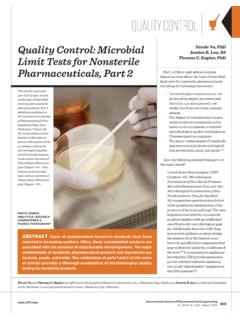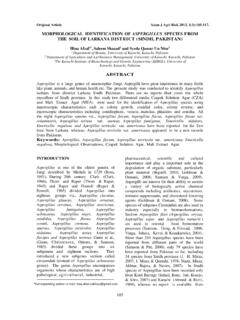Transcription of Quality Control Analytical Methods: Microbial Limit Tests ...
1 213 International Journal of Pharmaceutical CompoundingVol. 18 No. 3 | May | June | article represents part 1 of a 2-part article on the topic of Microbial Limit Tests for nonsterile pharmaceuticals. Part 1 provides valuable information on this topic, including an overview of United States Pharmacopeia Chapter <61>. Part 2 continues with this discussion, including an overview of United States Pharmacopeia Chapter <62>. Both parts of this series of articles contain information integral to contamination source: Analytical research laboraTories & pickeNs phoToGraphyAbstrAct contamination of pharmaceuticals with microorganisms may lead to deleterious effects on the therapeutic properties of the drug, and may potentially cause injuries to intended recipients. cases of contaminated nonsterile products have been reported in increasing numbers, and often associated with the presence of objectionable microorganisms.
2 Methods for detection of these organisms are described in three major pharmacopeias. Their functions and their limitations in the examination of microbiological Quality for nonsterile products will be reviewed in this report. Nonsterile pharmaceuticals are not pro-duced by aseptic processes and, therefore, are not expected to be totally free from Microbial contaminations. The degree of contamination in nonsterile products is regulated, and is based on the acceptance criteria for microbiological Quality estab-lished in Pharmacopeial monographs. A review of the Food and Drug Adminis-tration's (FDA) enforcement reports during 2004 2011 revealed that approximately 75% of nonsterile product recalls were in fact due to contaminated over-the-counter (OTC) or personal care products. The majority of these recalls were attributed to the following1: Presence of objectionable organisms (72%) Contamination levels exceeding micro-bial limits (15%) Sterility or Microbial diagnostic kit errors (7%) Failed microbiological Tests (5%) Manufacturing deficiencies (1%) The FDA has indicated that topical prep-arations contaminated with Gram-negative organisms are a probable moderate to serious health hazard, and that Burkhold-eria (Pseudomonas) cepacia is objectionable if found in a topical product or nasal solu-tion in high numbers.
3 The FDA concerns were obviously related to past incidents, where various infections and deaths were linked to contaminated Povidone-Iodine products, and Metaproterenol Sulfate Inha-lation Since then, aqueous-based inhalants are required to be The major contaminants of nonsterile pharmaceutical products and ingredients are bacteria, yeast, and molds. Even dry formulations are susceptible to Microbial contamination as the proliferation of microorganisms in solid dosage forms have been observed, especially in warm and humid climates. There are very few Quality Control Analytical methodS: Microbial Limit Tests for Nonsterile Pharmaceuticals, Part 1 Nicole Vu, PhDJessica R. Lou, BSThomas C. Kupiec, PhDNicole Vu and Thomas C. Kupiec are affiliated with Analytical Research Laboratories, Inc., Oklahoma City, Oklahoma; Jessica R. Lou is a PharmD Candidate at the Oklahoma University Health Science Center, Oklahoma City, controlaNalyTical meThods214 International Journal of Pharmaceutical CompoundingVol.
4 18 No. 3 | May | June | Controlproducts that possess self-preserving char-acteristics such as syrups, elixirs, and spirits; other multi-use pharmaceuticals usually contain antimicrobial preservatives to improve product Non-preserved drug products used in a hospital pharmacy for dose preparation have their own limitations even when they are supposed to be sterile. The final preparations are held for an extended period of time before administration to the patient, and are susceptible to Microbial growth during the holding Poor aseptic techniques have been linked to nosocomial outbreaks including S. aureus- and Enterobacter-laden propofol5 and Enterobacter- and P. aerugi-nosa-contaminated dextrose vials for multi-dose The propofol and dextrose tragedies each contributed to two deaths. Propofol, an intravenously-administered anesthetic, is available in both a preservative (metabisulfite or disodium edetate) and non-preservative formulation.
5 The low-lipid emulsion formulation is not preserved and promotes rapid Microbial growth at room Similarly, any product that is available in a dosage form intended for use in more than one patient (multi-dose) is worri-some for encouraging Microbial growth. While such dosage forms afford distinct cost-saving and convenience advantages, contamination in these multi-dose con-tainers pose a significant risk as a source for nosocomial Under current Good Manufacturing Prac-tices (cGMP), manufacturers are expected to maintain strict adherence to Microbial con-tamination Control practices during the pro-duction, and to develop Microbial specifications for their nonsterile The challenge for manufacturers, a challenge that may include outsourcing facilities, is to produce a nonsterile dosage form that does not exceed the recommended Limit for Microbial load, and is not contaminated with objection-able Objectionable microorganisms may be pathogens or opportunistic pathogens with their attendant metabolic activities and their Microbial characteristics such as exotoxins, endotoxins, sporulation, etc.
6 These microor-ganisms can grow under sub-optimal tempera-ture and nutrients and may affect product Quality and safety. Contamination at any steps in the manufacturing or compounding process represents significant risks to that process, which must be controlled to protect product Quality and United States Pharmacopeia (USP) Chap-ters <61> Microbiological Examination of Non-Sterile products: Microbial Enumeration Tests and <62> Microbiological Examination of Non-Sterile products: Tests for Specified Microorganisms provide protocols that allow quantitative enumeration of the presence of bacteria and fungi. The Tests help determine whether a nonsterile product complies with an established specification for microbiologi-cal Quality . Additionally, these two USP chap-ters provide guidance on determining the absence of, or the limited occurrence of, speci-fied microorganisms that may be detected under the conditions of the It is neces-sary to emphasize here that the USP provides methodologies for selected indicator organ-isms, but not all objectionable organisms in the FDA criteriA for MicrobiologicAl Quality of non-sterile phArMAceuticAls The Microbial limits recommended in USP General Chapter <1111> Microbiological Examination of Non-Sterile products: Accep-tance criteria For Pharmaceutical Prepara-tions and Substances For Pharmaceutical Use are based on the total aerobic Microbial count (TAMC), total combined yeasts and molds count (TYMC), and Tests for absence of the specified organisms by route of administra-tion (Table 1).
7 11 The USP expresses the follow-ing conditions in applying the acceptance Innovative Sterile Productsfor Compounding offers a complete range of products designed specifically for sterile compounding including our renowned line of Prep-LockTM Tamper Evident Caps for luer lock syringes. Easy installation for the pharmacy and easy removal for the more fumbling with sticky, brittle tape or bulky bags. Secure your sterile IV preparations and enhance USP <797> compliance!FREE Sterile Samples for Evaluation!International Medical Industries, s UnderYour Hood?Pharmaceutical Compounding 12/17/2014 11:24:49 AM215 International Journal of Pharmaceutical CompoundingVol. 18 No. 3 | May | June | ControlTABLe 1. United States Pharmacopeia (Chapter <1111>) Acceptance Criteria for Microbiological Quality of Nonsterile Dosage TAMC TYMC ABSeNCe OF SPeCIFIeDROUTe OF (CFU/G, (CFU/G, MICROORGANISM(S) ADMINISTRATION CFU/ML) CFU/ML) (1 G, 1 ML)aOral (non-aqueous) 10 10 Escherichia coliOral (aqueous)
8 10 10 Escherichia coliRectal 10 10 None designatedOromucosal 10 10 Staphylococcus aureus Pseudomonas aeruginosa Gingival 10 10 Staphylococcus aureus Pseudomonas aeruginosaCutaneous 10 10 Staphylococcus aureus Pseudomonas aeruginosa Nasal 10 10 Staphylococcus aureus Pseudomonas aeruginosa Auricular 10 10 Staphylococcus aureus Pseudomonas aeruginosa Vaginal 10 10 Pseudomonas aeruginosa Staphylococcus aureus Candida albicans Transdermal Patch (drug matrix, 10 10 Staphylococcus aureusadhesive layer and backing)
9 Pseudomonas aeruginosa Inhalation 10 10 Staphylococcus aureus Pseudomonas aeruginosa Bile-tolerant Gram-negative bacteriaPharmaceutical substances 10 10 None designatedaMinimum amount of product to be used in sample preparation; cfu = colony-forming unit; TAMC = total aerobic Microbial count; TyMC = total combined yeasts and molds countcriteria for evaluation of product Quality :1. The microbiological test methods are highly variable and must be validated with a Limit of detection as close as possible to the indicated acceptance The list of microorganisms in Table 1 is not exhaustive: The significance of other microorganisms recovered should be evaluated in terms of route of administration, the nature of the product ( , growth promotion prop-erties), the method of application, the intended recipient (neonates, infants, debilitated conditions, etc.)
10 , the use of immunosuppressive agents, and the presence of disease or organ damage. 3. Acceptance criteria are applied to indi-vidual results or the average of repli-cate counts in colony-forming units per gram or mL of the product (cfu/g or cfu/mL). The maximum acceptable range for Microbial enumeration is 2 times (or log10) the Limit . For example, results for a TAMC ranging from 5 20 cfu/mL would meet the specification of 10 of USP chApter <61>: Microbial enuMerAtion Tests USP Chapter <61> provides Tests for the quantitative determination of total aerobic Microbial count, and TYMC that might be present in pharmaceutical ingredients and finished These methods are not applicable to products containing viable microorganisms as active ingredients. Alter-nate procedures may be used, but must show to be equivalent to Pharmacopeial methods.








